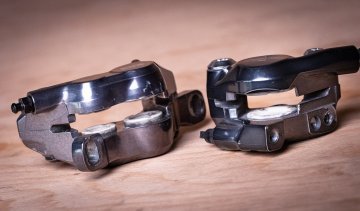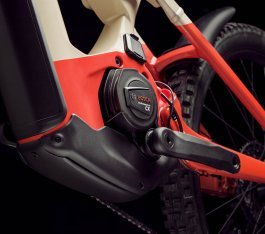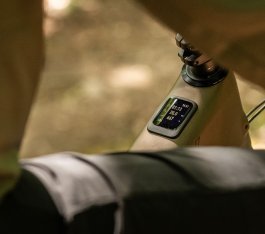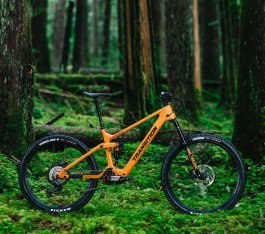
2 or 4-piston brake?
Disc brakes are now standard on most bikes and e-bikes. Here’s how to decide whether a 2- or 4-piston brake is right for you.
E-Mountainbikes have added an exciting new dimension to the MTB world. We explain which motor system is the best for you.
In Germany, far more E-Mountainbikes are now sold than “classic” mountain bikes without motors. No surprise – the range of motor and drive systems is huge, making it possible to find the right bike for every type of rider.
But which motor is right for you? In this article we’ll give you some guidance – and in the post “Why you'll Never get enough of e-MTBs” you can find out what makes these off-road bikes with built-in tailwind so special.
With an E-MTB, even technical climbs are more fun – the only question is which drive system is right for you! © Cannondale
On E-Mountainbikes, the mid-drive motor is king and by far the most dominant drive system. The motor sits low and centrally in the frame, ensuring an optimal centre of gravity, while the unsprung masses on the front and rear wheels remain typically light for mountain bikes. The former provides even weight distribution, better cornering grip and high riding stability, while the latter improves the suspension response. Unlike on city e-bikes, gravel e-bikes or road e-bikes, rear hub motors play no role in E-MTBs.
If it’s an E-MTB, it has a mid-drive motor: there’s practically no exception to this rule. The heavy component sits low and central in the frame, offering maximum control and balance. © Cannondale
Not only in this article do we often colloquially talk about E-bike “motors”; what we actually mean, however, are “drive units” – precisely the combination of a motor (!) that converts electrical energy into mechanical power and a gearbox that delivers it to the chainring of your E-bike at the right cadence.
Two different motor concepts dominate the E-MTB market. While full-power systems focus on maximum strength and acceleration, light E-MTB drives ensure agile handling similar to the best mountain bikes thanks to their low weight. The former deliver seemingly endless turbo thrust and, with motocross-like riding dynamics, smooth out even the roughest hits. The latter ride like your non-motorised MTB – but with extra power – and are easy to lean into corners or lift onto the rear wheel.
No one seriously claims anymore that E-MTBs are just sports equipment for early retirees. © Orbea
With maximum torques of around 100 newton metres, peak outputs of about 700 watts and large batteries of 700 watt-hours or more, full-power systems are just right for you if you always need maximum performance. Even at low cadences, they deliver plenty of pulling power and push you up the steepest and longest climbs with lots of uphill flow. Thanks to their brute force, full-power drive systems also excel when accelerating out of tight, slow corners.

The Bosch CX has been the market leader among e-bike drives for years. © Cannondale
The market leader with the highest share among E-MTB motors comes from Reutlingen. The drives of the Bosch Performance Line CX series deliver up to 750 watts of peak power in their latest version, support your own pedalling effort by up to 400 percent and provide a maximum torque of 100 Nm. The new R variant saves some weight compared to the well-known CX motor and, for the first time, introduces a new Race mode. Even the older CX and CX Race versions with 85 Nm and 600 watts of peak output are by no means underpowered. In addition, Bosch offers a free motor control software update for the smart CX motors of the fifth generation, allowing them to achieve the same performance values as the latest revised drives. The Bosch CX motors weigh between 2.7 and 3 kilograms.
Key data Bosch Performance CX:
The Bosch E-MTB motors are “Made in Germany” and, within Bosch’s “Smart System”, can be controlled and customised via app with numerous digital additional functions. The “eShift” mode enables automatic shifting in combination with compatible gears.
In the smart system, batteries between 400 and 800 watt-hours, a range extender with 250 watt-hours and no fewer than nine display/controller units are available, ranging from the minimalist LED Remote to the 2.8-inch Kiox display.
Conclusion: At Bosch, everyone finds what they need. Mountain bike manufacturers make use of the high modularity of the Bosch system for a wide variety of specialised models. Made in Germany, proven millions of times: you can’t go wrong here – and you’ll even be provided with new features via updates after your purchase.
In its fifth iteration, the Bosch CX is the top dog among full-power drives. © bc GmbH
In 2025 the unit increased from 85 to 100 Nm and weighs 2,845 grams in the bc studio. © bc GmbH
The EP8 line with the EP-801 and the older EP-800 motor represents the spearhead of the Japanese shifting giant’s drive systems. It delivers up to 600 watts and 85 newton metres, while still being relatively light for a full-power drive at a measured 2,700 grams. This is made possible by a magnesium motor housing. Interestingly, the specialist magazine Bike attests that Shimano’s top motor delivers its maximum output of 600 watts with a very low measured rider input of just 110 watts, awarding it the label “light powerhouse”. Mathematically, this results in a maximum support of over 500 percent.
Key data Shimano EP801:
As with Bosch, the EP801 is part of an entire ecosystem of batteries and displays. If you prefer a clean cockpit, the minimalist controller and the display mounted beneath the handlebar are interesting. This way, you can also turn the bike upside down in the event of a puncture without scratching the display.
In the interaction between drivetrain and motor, Shimano plays to its full strengths. The EP801 can directly communicate with an in-house Di2 electronic shifting system. This not only enables an automatic mode but also technical refinements such as a brief reduction of support during shifting for faster, smoother and less wear-intensive gear changes. Particularly interesting on the trail: the Free Shift mode allows shifting even when coasting. According to the manufacturer: “When coasting, the drive unit provides just enough power to let the chainring and cassette complete a gear change without affecting the bike’s acceleration” (source).
The 801RS version, used for example by the Basque manufacturer Orbea in its Rise models, bridges the gap to the light E-MTB with its curve-adjusted “Rider Synergy” Natural Support mode, but still provides full torque when required. Here the rule applies: the more you put in, the more you get out.
With Shimano too, you can use an app to customise the motor and battery to your personal needs.
The Shimano EP8 has also been around for a while and was updated in 2022 for digital integration. © bc GmbH
With its magnesium housing, the EP8 weighs 2,700 grams and delivers up to 85 Nm. © bc GmbH
In many ways the little brother of the top model EP801, the EP601 offers the same performance data in a more affordable but slightly heavier aluminium housing. Features such as “Auto Shift” and “Free Shift” are also available, as well as access to the app.
Conclusion: With Shimano, seamless integration meets sportiness. If you want your drive and drivetrain to work hand in hand and you’re into automated shifting functions so you can fully focus on the trail – look no further!

For some time now, the trend has been towards displays integrated into the top tube. © bc GmbH
With the latest evolution of its full-power drive, the Californian brand Specialized has really pulled out all the stops. In the most expensive S-Works configuration, the motor delivers an impressive 720 watts of peak power and up to 111 Nm of torque, paired with a battery capacity of 840 watt-hours. This makes the 3.1 S-Works currently (summer 2025) one of the most powerful motors on the market. If you want that much performance, you’ll have to dig deep for the S-Works top models – but in return you get high-end everywhere you look.
Key data Specialized 3.1:
Even the standard version, with a maximum of 666 watts and 101 Nm, is anything but underpowered. The S-Works version, however, puts 111 Nm and 720 watts of peak output onto the chain.
With its muscles, the motor has also gained some weight, tipping our scales at exactly 3,116 grams. The system comes with batteries of 600 or 840 watt-hours capacity, plus an optional 280 Wh range extender.
As always with Specialized, there is a very clean top-tube-integrated display, extensive configuration and customisation options via app, and a minimalist controller. The motto here is focus on the essentials: the trail.
The Specialized motor is available exclusively in Specialized E-bikes.
Conclusion: The current state of the art, beautifully packaged. Whether you want a Specialized bike because of this motor or the motor because of the Specialized bike – in the end it doesn’t matter. They simply belong together like ketchup and fries.
The Specialized 3.1 was introduced in 2025 and, with 101 Nm (111 Nm in the S-Works version), is the most powerful drive in the field. © bc GmbH
At 3,116 grams, however, it is also the heavyweight leader. © bc GmbH
As with their more powerful siblings, the name says it all for light E-MTB drives: their significantly lower weight is achieved through less peak power and smaller batteries. This makes E-MTBs from 16 kilograms possible – hardly heavier than your enduro! Still, light E-MTBs are no weaklings. At higher cadences they deliver a smooth and natural power curve, similar to a bio-bike – just with more power. You decide, with your cadence and power output, how much assistance the motor adds. On the plus side, they also consume less energy and often generate less noise.

Modern E-MTBs are recognisable by the fact that they don’t look like E-MTBs. © Transition
The Performance Line SX motor is Bosch’s first light E-MTB drive and much more than just the little sister of the big CX. With a maximum torque of 55 Nm and an output of up to 600 watts, it supports you quite powerfully on the trail despite its low weight of just over two kilograms – but as with most light drives, the focus is on a smooth and balanced power delivery.
Key data Bosch Performance SX:
The Bosch Performance SX drive comes as standard with the 400 Wh CompactTube battery and can be expanded with the in-house 250 Wh range extender. All in-app features of Bosch’s smart system are of course also available for the SX.
Conclusion: All the strengths of the Bosch system in a lighter, more compact, energy-saving package.
The e-bike community had to wait a long time for the Bosch SX. The light E-MTB drive from Reutlingen was introduced in 2023. © bc GmbH
At just over 2 kg and 55 Nm torque, the Bosch SX is a typical representative of the light-support segment, yet delivers up to 600 watts. © bc GmbH
The Ride 60 from the Bavarian manufacturer Fazua (from “Fahr zua!”, dialect for “step on it!”) was one of the very first light E-MTB drives. Years of continuous evolution have turned the Ride 60, produced in Germany, into an extremely well-balanced and quiet overall package. But: like a traditional naturally aspirated sports car from Fazua’s parent company Porsche, the Ride 60 needs revs – i.e. cadence – to function optimally. At a cadence of 50, sitting low in the saddle with knees apart, you’re wasting potential.
Key data Fazua Ride 60:
Speaking of fun: Fazua’s very clean and minimalistic operating concept has its charm. The Ring Control for selecting support levels and briefly activating Boost Mode is intuitive to use, and the top tube’s charge indicator is very discreet. A nice extra: it has a hidden USB-C port to charge your gadgets. The motor is also so compact and quiet that it’s hardly noticeable that it’s an E-bike.
The system communicates via ANT+ with compatible devices, providing data such as support intensity or rider input.
Despite all this compactness and the low weight of around two kilograms, the Ride 60 delivers the eponymous 60 newton metres of torque and a maximum output of 450 watts. Customisation of performance profiles via app is possible. The new Fazua standard battery provides 480 watt-hours (previously 430 Wh). However, the range extender promised at the system’s launch will, according to the latest information, not be released.
Conclusion: A well-balanced all-rounder in the light E-MTB world. Smooth, intuitive, quiet – yet with plenty of torque and power when you need it.
The former startup Fazua now belongs to the Porsche group. The Ride 60 delivers 60 Nm and up to 450 watts and is half-hidden in the frame’s down tube. © bc GmbH
At 2,063 grams, the Ride 60 is one of the lightest e-bike drives and allows for slim, elegant frame designs. © bc GmbH
“The lightest. The smallest. The quietest.” That is the promise made by the Bavarian manufacturer TQ for its HPR50 drive, introduced in 2022. At 1,860 grams, the claim is very credible. The concentric motor is indeed so small that it disappears behind the chainring and operates almost silently. Nevertheless, it delivers 300 watts and 50 newton metres of maximum torque. You decide, with your cadence and your own input, how dynamic and fast things get. Like the Fazua, the TQ also requires a certain cadence to unfold its full potential.
Key data TQ HPR50:
Available are three batteries with capacities between 250 and 580 watt-hours, as well as an optional range extender with 160 watt-hours. Remarkably, at 900 grams the additional battery weighs less than a filled water bottle, which it replaces if required.
The operation of the TQ, produced in Germany, is extremely intuitive, with a clean, minimalist design. Nothing should distract you from riding. All further settings can be made in the app – just as the motor characteristics, support levels and more can be customised to your preferences. The high-contrast TQ display is integrated into the top tube of your e-bike and provides key information such as charge level, range and selected support at a glance.
Via ANT+ sensor you can connect your smartphone or your bike computer directly to the bike and, for example, read out performance data.
Conclusion: The figures already show it: the term “Natural Support” could have been invented for this drive. A motor for athletes who want to ride their E-MTB like their mountain bike and still have that decisive punch when it counts.
With its concentric Harmonic Pin Ring gearbox, the HPR50 is particularly compact and quiet in operation. © bc GmbH
At just 1,860 grams, the Bavarian powerhouse is also the lightest drive in the field. Once installed, the TQ discreetly disappears behind the chainring and crank. © bc GmbH
Hardly larger and only 114 grams heavier than the HPR50, the TQ HPR60, introduced in 2025, delivers 20% more torque with its eponymous 60 Nm and 350 watts of peak power. This compact powerhouse thus plays in the same league as the Fazua and the Bosch SX, but thanks to its concentric design it is significantly more compact than the two competitors. Our scales show exactly 1,947 grams for the big brother from Inning am Ammersee, and apart from the new distinctive cooling fins on the underside of the unit, it appears exactly the same size as its predecessor, which has been shaking up the light E-MTB sector with great success since 2022.
Key data TQ HPR60:
The TQ ecosystem, consisting of the compact handlebar remote, high-contrast top tube displays, batteries and range extender, is shared by both innovative drives. Speaking of batteries: TQ currently offers energy storage units with 290, 360 and 580 watt-hours in its portfolio. The in-house range extender adds another 160 Wh to your bottle cage.
Conclusion: Considered the successor to the HPR50, the TQ HPR60 is a very compact and still remarkably quiet E-MTB drive. Its great potential for slim, sporty light E-MTBs, which don’t immediately look like E-bikes, makes overall weights well below 20 kg easily possible. The motor is especially worthwhile for sporty riders, agile riding styles and also for lighter persons.
Externally, the HPR60 differs from its predecessor only by the cooling fins mounted underneath. © bc GmbH
At 1,974 grams, the new TQ is only 114 grams heavier than its predecessor despite a 20% increase in power. © bc GmbH
“More power means more energy consumption, means a bigger battery, means more weight.” This equation isn’t wrong, but range extenders challenge it: these handy additional batteries in the shape of a water bottle usually add 160 to 250 extra watt-hours of capacity. With a range extender you can enjoy a quick evening ride with a smaller battery and lighter bike, while for a big tour you simply mount the extra battery in just a few steps.
Especially with light-support E-MTBs, range extenders are a popular gadget for extra range or, once the main battery is removed, for rides with a weight advantage! © Transition
Currently, the Specialized 3.1 with its 101 or 111 Nm in the S-Works version, as well as the Bosch Performance Line CX with 100 Nm, are among the strongest E-MTB motors in terms of power and torque. However, performance isn’t everything: light E-MTBs score with low weight, agile handling and a natural riding feel.
The rated continuous power is the mechanical power your bike’s motor can deliver on a permanent basis. According to EU law, rated continuous power for pedelecs (commonly referred to as “e-bikes”) is limited to 250 watts over 30 minutes. The peak power the motor may deliver in the short term, e.g. on a steep climb, can be significantly higher. Current top drives deliver more than 800 watts peak power.
There is no one-size-fits-all answer. The energy consumption of an E-MTB motor depends on many factors such as terrain, gradient, support level, temperature, rider input and the maintenance condition of the drive. Optional additional batteries (“range extenders”) or a spare battery in the backpack can extend the range as needed.
Again, it depends: depending on your personal fitness, motor system and chosen support mode, the range of modern e-bikes varies widely, but for a Bosch CX, for example, it can easily be 70 kilometres or more.
Maximum torque (measured in newton metres) is an important indicator of an e-bike’s power delivery. In addition to torque, peak power (in watts) and maximum support (in percent of rider input) also provide key insights into the strength of the e-bike motor.
The mid-drive motor sits centrally at the bottom bracket in the frame and is directly connected to the crank arms. It supports the power applied by the rider and transfers it via the chain or belt to the rear wheel.
That depends on your preferences and requirements. Riders looking for agile, natural and sporty handling and who are willing to put in their own effort will get along fine with a light E-MTB motor offering 50 to 60 newton metres of torque. If you weigh more than 75 kg and are looking for brutal turbo thrust even at low cadences, you should look for more torque.